美国专利法核心内容
- 格式:doc
- 大小:35.50 KB
- 文档页数:4
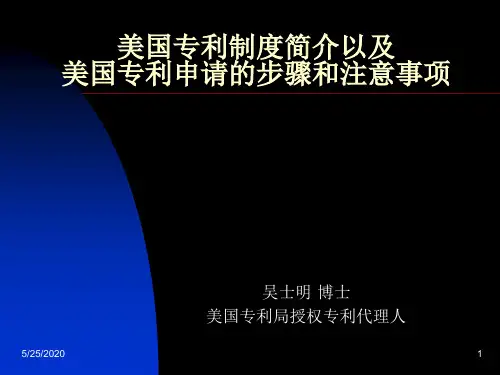
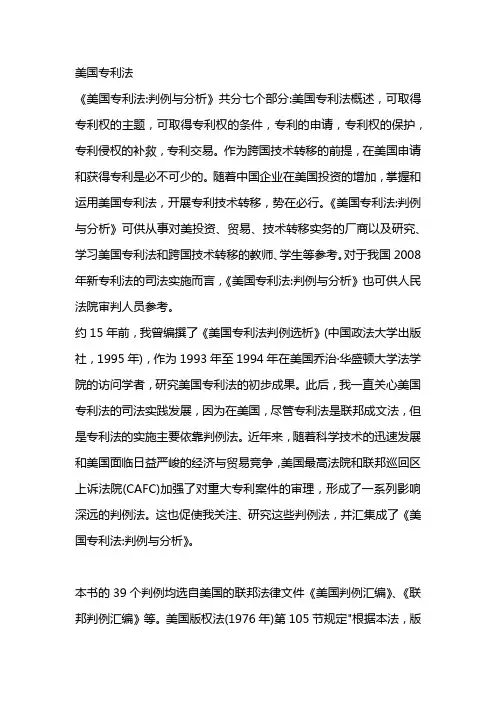
美国专利法《美国专利法:判例与分析》共分七个部分:美国专利法概述,可取得专利权的主题,可取得专利权的条件,专利的申请,专利权的保护,专利侵权的补救,专利交易。
作为跨国技术转移的前提,在美国申请和获得专利是必不可少的。
随着中国企业在美国投资的增加,掌握和运用美国专利法,开展专利技术转移,势在必行。
《美国专利法:判例与分析》可供从事对美投资、贸易、技术转移实务的厂商以及研究、学习美国专利法和跨国技术转移的教师、学生等参考。
对于我国2008年新专利法的司法实施而言,《美国专利法:判例与分析》也可供人民法院审判人员参考。
约15年前,我曾编撰了《美国专利法判例选析》(中国政法大学出版社,1995年),作为1993年至1994年在美国乔治·华盛顿大学法学院的访问学者,研究美国专利法的初步成果。
此后,我一直关心美国专利法的司法实践发展,因为在美国,尽管专利法是联邦成文法,但是专利法的实施主要依靠判例法。
近年来,随着科学技术的迅速发展和美国面临日益严峻的经济与贸易竞争,美国最高法院和联邦巡回区上诉法院(CAFC)加强了对重大专利案件的审理,形成了一系列影响深远的判例法。
这也促使我关注、研究这些判例法,并汇集成了《美国专利法:判例与分析》。
本书的39个判例均选自美国的联邦法律文件《美国判例汇编》、《联邦判例汇编》等。
美国版权法(1976年)第105节规定"根据本法,版权保护不适用于美国政府的任何作品(any work of the united States Covernment),……"其中包括联邦法院的判例。
本书的分析是我对上述39个判例以及相关的大量判例进行初步研究,并参阅有关文献(详见主要参考文献目录)后作出的。
对于所引文献的作者,在此一并表示衷心的谢意。
本书的译名基本上以《英语姓名译名手册》(第二次修订本,新华通讯社译名资料组编,商务印书馆,1985年版)为准;科技术语的译法主要参考了《英汉大词典》(陆谷孙主编,上海译文出版社,1993年8月第1版)和《简明英汉科技词典》(商务印书馆,1983年修订版)。
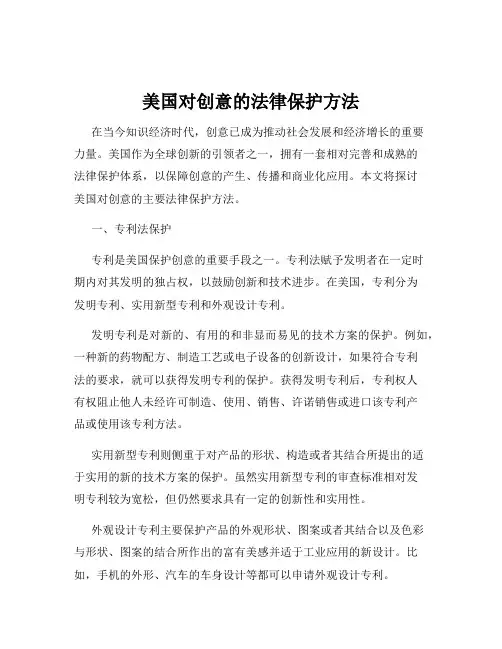
美国对创意的法律保护方法在当今知识经济时代,创意已成为推动社会发展和经济增长的重要力量。
美国作为全球创新的引领者之一,拥有一套相对完善和成熟的法律保护体系,以保障创意的产生、传播和商业化应用。
本文将探讨美国对创意的主要法律保护方法。
一、专利法保护专利是美国保护创意的重要手段之一。
专利法赋予发明者在一定时期内对其发明的独占权,以鼓励创新和技术进步。
在美国,专利分为发明专利、实用新型专利和外观设计专利。
发明专利是对新的、有用的和非显而易见的技术方案的保护。
例如,一种新的药物配方、制造工艺或电子设备的创新设计,如果符合专利法的要求,就可以获得发明专利的保护。
获得发明专利后,专利权人有权阻止他人未经许可制造、使用、销售、许诺销售或进口该专利产品或使用该专利方法。
实用新型专利则侧重于对产品的形状、构造或者其结合所提出的适于实用的新的技术方案的保护。
虽然实用新型专利的审查标准相对发明专利较为宽松,但仍然要求具有一定的创新性和实用性。
外观设计专利主要保护产品的外观形状、图案或者其结合以及色彩与形状、图案的结合所作出的富有美感并适于工业应用的新设计。
比如,手机的外形、汽车的车身设计等都可以申请外观设计专利。
二、著作权法保护著作权法在美国为创意作品提供了广泛的保护。
著作权保护的对象包括文学、艺术和科学领域内具有独创性并能以一定形式表现的作品,如小说、诗歌、音乐、电影、软件等。
一旦作品创作完成,作者就自动享有著作权。
著作权赋予作者对其作品的复制、发行、表演、展示、改编等一系列权利。
这意味着未经作者许可,他人不得擅自复制、传播或修改其作品。
在美国,著作权保护期限较长,对于个人作者,其作品的保护期限为作者有生之年加死后 70 年;对于法人作品,保护期限为首次发表后95 年或创作完成后 120 年,以较短者为准。
三、商标法保护商标是用于区分商品或服务来源的标志,包括文字、图形、字母、数字、三维标志、颜色组合和声音等。
美国的商标法通过保护商标所有者的专用权,确保消费者能够准确识别商品或服务的来源,同时也保护了企业在品牌建设和市场推广方面的创意投入。
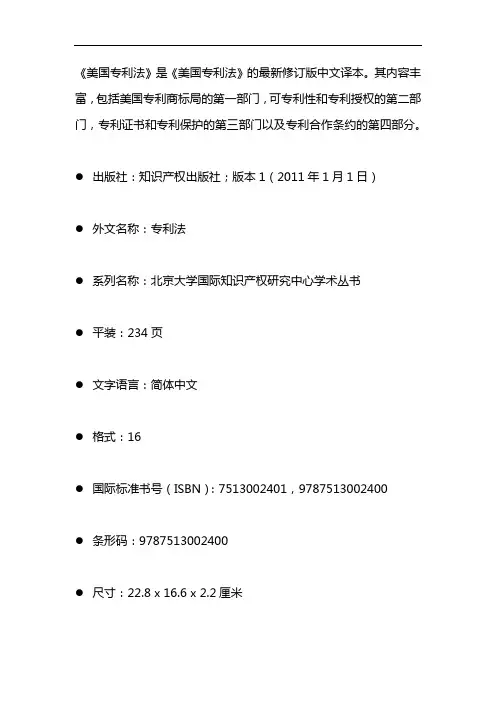
《美国专利法》是《美国专利法》的最新修订版中文译本。
其内容丰富,包括美国专利商标局的第一部门,可专利性和专利授权的第二部门,专利证书和专利保护的第三部门以及专利合作条约的第四部分。
●出版社:知识产权出版社;版本1(2011年1月1日)
●外文名称:专利法
●系列名称:北京大学国际知识产权研究中心学术丛书
●平装:234页
●文字语言:简体中文
●格式:16
●国际标准书号(ISBN):7513002401,9787513002400
●条形码:9787513002400
●尺寸:22.8 x 16.6 x 2.2厘米
重量:399克
专利法是由乔治华盛顿法学院的教授MartinJ.Adelman,美国联邦上诉法院法官RandallR.Rader和美国知识产权律师CordonP.Klancnik共同撰写的。
这是一本由美国40多个著名大学的法学院指定的教科书。
专利法分为16章。
完整介绍了美国专利法的基本理论,专利获取,专利资格,实用性,期望,法律否认,新颖性,非显而易见性,适当披露,专利权利要求,其他辩护方法,侵权救济,国际专利法等,从专利获取到实施,涵盖与知识产权和法院案件有关的法律法规。
美国《专利法》适合作为大学教科书,它还为律师,公司法律事务及其他相关领域的从业人员提供完整的参考数据。
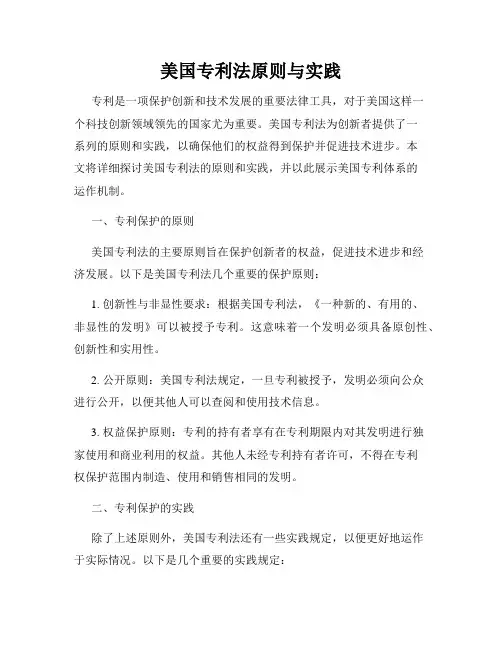
美国专利法原则与实践专利是一项保护创新和技术发展的重要法律工具,对于美国这样一个科技创新领域领先的国家尤为重要。
美国专利法为创新者提供了一系列的原则和实践,以确保他们的权益得到保护并促进技术进步。
本文将详细探讨美国专利法的原则和实践,并以此展示美国专利体系的运作机制。
一、专利保护的原则美国专利法的主要原则旨在保护创新者的权益,促进技术进步和经济发展。
以下是美国专利法几个重要的保护原则:1. 创新性与非显性要求:根据美国专利法,《一种新的、有用的、非显性的发明》可以被授予专利。
这意味着一个发明必须具备原创性、创新性和实用性。
2. 公开原则:美国专利法规定,一旦专利被授予,发明必须向公众进行公开,以便其他人可以查阅和使用技术信息。
3. 权益保护原则:专利的持有者享有在专利期限内对其发明进行独家使用和商业利用的权益。
其他人未经专利持有者许可,不得在专利权保护范围内制造、使用和销售相同的发明。
二、专利保护的实践除了上述原则外,美国专利法还有一些实践规定,以便更好地运作于实际情况。
以下是几个重要的实践规定:1. 专利审查:根据美国专利法,所有提交的专利申请必须经过审查来确定其是否符合授予专利的要求。
审查过程包括对相关技术领域的背景调查、对申请提交的发明的搜索和评估。
2. 专利权期限:美国专利法规定,专利的权益期限一般为20年,从申请日开始计算。
在权益期限内,专利持有者可以对其发明享有独家权益,同时也有义务在专利期满后将技术信息公开。
3. 专利侵权保护:一旦发现他人侵犯自己的专利权益,专利持有者可以通过起诉侵权方来保护自己的权益。
美国专利法赋予专利持有者追究侵权方责任的权利,并可以获得相应的赔偿。
三、美国专利体系的运作机制为了保护创新者的权益和促进技术进步,美国建立了完善的专利体系,包括专利局、法院和专利审查委员会等。
这些机构起到了至关重要的作用,以确保专利法的有效实施和专利的强制执行。
1. 美国专利局:美国专利局是负责专利审查和发行的主要机构。
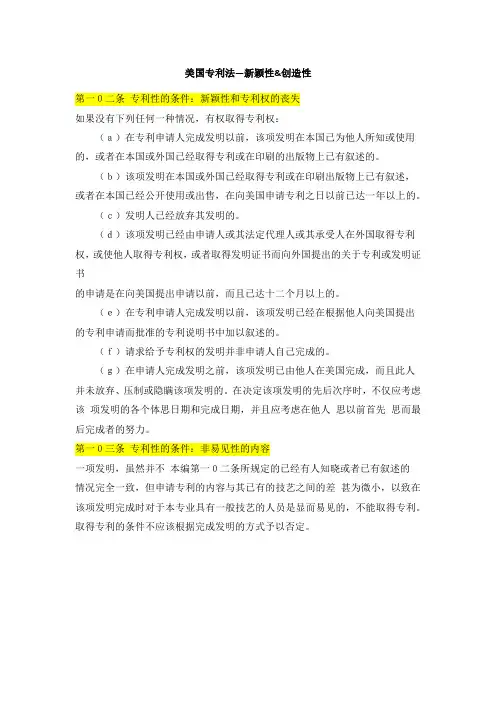
美国专利法—新颖性&创造性
第一0二条专利性的条件:新颖性和专利权的丧失
如果没有下列任何一种情况,有权取得专利权:
(a)在专利申请人完成发明以前,该项发明在本国已为他人所知或使用的,或者在本国或外国已经取得专利或在印刷的出版物上已有叙述的。
(b)该项发明在本国或外国已经取得专利或在印刷出版物上已有叙述,或者在本国已经公开使用或出售,在向美国申请专利之日以前已达一年以上的。
(c)发明人已经放弃其发明的。
(d)该项发明已经由申请人或其法定代理人或其承受人在外国取得专利权,或使他人取得专利权,或者取得发明证书而向外国提出的关于专利或发明证书
的申请是在向美国提出申请以前,而且已达十二个月以上的。
(e)在专利申请人完成发明以前,该项发明已经在根据他人向美国提出的专利申请而批准的专利说明书中加以叙述的。
(f)请求给予专利权的发明并非申请人自己完成的。
(g)在申请人完成发明之前,该项发明已由他人在美国完成,而且此人并未放弃、压制或隐瞒该项发明的。
在决定该项发明的先后次序时,不仅应考虑该项发明的各个体思日期和完成日期,并且应考虑在他人思以前首先思而最后完成者的努力。
第一0三条专利性的条件:非易见性的内容
一项发明,虽然并不本编第一0二条所规定的已经有人知晓或者已有叙述的
情况完全一致,但申请专利的内容与其已有的技艺之间的差甚为微小,以致在该项发明完成时对于本专业具有一般技艺的人员是显而易见的,不能取得专利。
取得专利的条件不应该根据完成发明的方式予以否定。
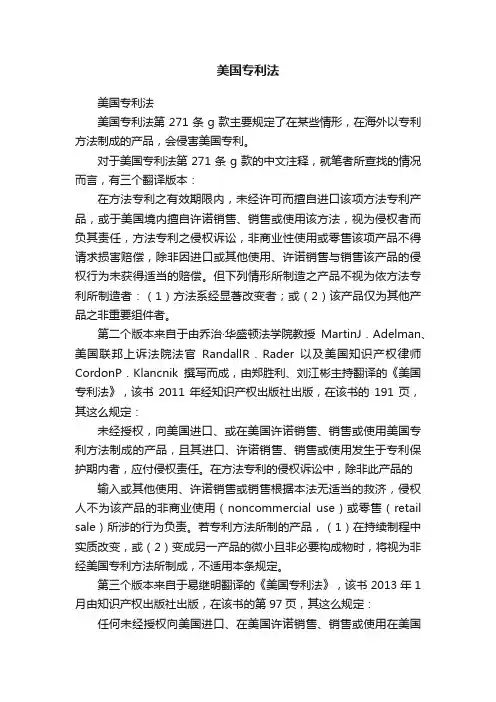
美国专利法美国专利法美国专利法第271条g款主要规定了在某些情形,在海外以专利方法制成的产品,会侵害美国专利。
对于美国专利法第271条g款的中文注释,就笔者所查找的情况而言,有三个翻译版本:在方法专利之有效期限内,未经许可而擅自进口该项方法专利产品,或于美国境内擅自许诺销售、销售或使用该方法,视为侵权者而负其责任,方法专利之侵权诉讼,非商业性使用或零售该项产品不得请求损害赔偿,除非因进口或其他使用、许诺销售与销售该产品的侵权行为未获得适当的赔偿。
但下列情形所制造之产品不视为依方法专利所制造者:(1)方法系经显著改变者;或(2)该产品仅为其他产品之非重要组件者。
第二个版本来自于由乔治·华盛顿法学院教授MartinJ.Adelman、美国联邦上诉法院法官RandallR.Rader以及美国知识产权律师CordonP.Klancnik撰写而成,由郑胜利、刘江彬主持翻译的《美国专利法》,该书2011年经知识产权出版社出版,在该书的191页,其这么规定:未经授权,向美国进口、或在美国许诺销售、销售或使用美国专利方法制成的产品,且其进口、许诺销售、销售或使用发生于专利保护期内者,应付侵权责任。
在方法专利的侵权诉讼中,除非此产品的输入或其他使用、许诺销售或销售根据本法无适当的救济,侵权人不为该产品的非商业使用(noncommercial use)或零售(retail sale)所涉的行为负责。
若专利方法所制的产品,(1)在持续制程中实质改变,或(2)变成另一产品的微小且非必要构成物时,将视为非经美国专利方法所制成,不适用本条规定。
第三个版本来自于易继明翻译的《美国专利法》,该书2013年1月由知识产权出版社出版,在该书的第97页,其这么规定:任何未经授权向美国进口、在美国许诺销售、销售或使用在美国获得专利权的专利方法制造的产品的,如果进口、许诺销售、销售或使用行为发生在专利保护期内,则行为人应负侵权之责。

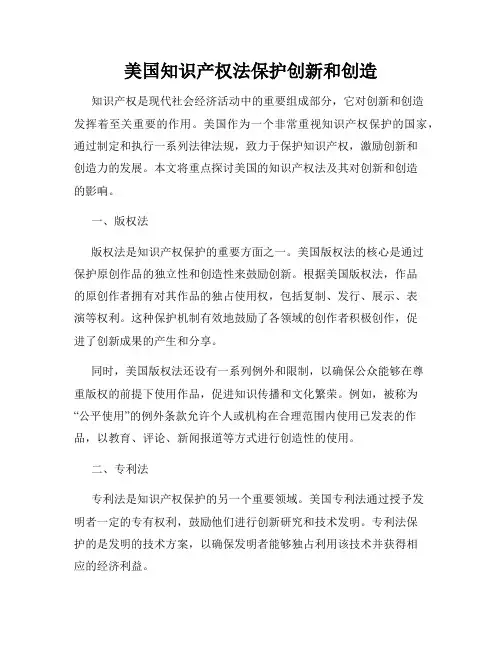
美国知识产权法保护创新和创造知识产权是现代社会经济活动中的重要组成部分,它对创新和创造发挥着至关重要的作用。
美国作为一个非常重视知识产权保护的国家,通过制定和执行一系列法律法规,致力于保护知识产权,激励创新和创造力的发展。
本文将重点探讨美国的知识产权法及其对创新和创造的影响。
一、版权法版权法是知识产权保护的重要方面之一。
美国版权法的核心是通过保护原创作品的独立性和创造性来鼓励创新。
根据美国版权法,作品的原创作者拥有对其作品的独占使用权,包括复制、发行、展示、表演等权利。
这种保护机制有效地鼓励了各领域的创作者积极创作,促进了创新成果的产生和分享。
同时,美国版权法还设有一系列例外和限制,以确保公众能够在尊重版权的前提下使用作品,促进知识传播和文化繁荣。
例如,被称为“公平使用”的例外条款允许个人或机构在合理范围内使用已发表的作品,以教育、评论、新闻报道等方式进行创造性的使用。
二、专利法专利法是知识产权保护的另一个重要领域。
美国专利法通过授予发明者一定的专有权利,鼓励他们进行创新研究和技术发明。
专利法保护的是发明的技术方案,以确保发明者能够独占利用该技术并获得相应的经济利益。
美国的专利制度分为两种类型:实用新型专利和发明专利。
实用新型专利保护的是新颖的、实用的和非显而易见的技术方案,而发明专利则保护的是更具创造性和技术含量的发明。
专利权的授予有助于激励创新者在面临风险和困难时持续进行创新和研发工作。
三、商标法商标法是知识产权保护的另一个重要方面。
商标是用于标识和区分商品或服务来源的标志,其对企业的品牌形象和市场地位具有重要意义。
美国商标法通过注册商标,保护商标所有人的独占使用权,并确保消费者能够准确识别和区分不同品牌的商品或服务。
美国商标法要求商标具有独特性、可区别性和非功能性。
商标所有人可以通过商标使用许可协议授权他人使用其商标,并根据协议规定收取一定的使用费用。
商标保护不仅鼓励企业进行创新和品牌建设,也保护了消费者的利益,确保他们能够购买到可信赖的商品和服务。
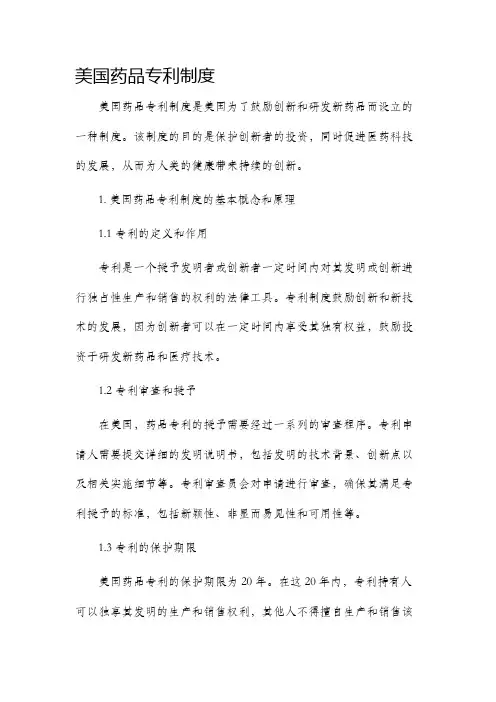
美国药品专利制度美国药品专利制度是美国为了鼓励创新和研发新药品而设立的一种制度。
该制度的目的是保护创新者的投资,同时促进医药科技的发展,从而为人类的健康带来持续的创新。
1. 美国药品专利制度的基本概念和原理1.1 专利的定义和作用专利是一个授予发明者或创新者一定时间内对其发明或创新进行独占性生产和销售的权利的法律工具。
专利制度鼓励创新和新技术的发展,因为创新者可以在一定时间内享受其独有权益,鼓励投资于研发新药品和医疗技术。
1.2 专利审查和授予在美国,药品专利的授予需要经过一系列的审查程序。
专利申请人需要提交详细的发明说明书,包括发明的技术背景、创新点以及相关实施细节等。
专利审查员会对申请进行审查,确保其满足专利授予的标准,包括新颖性、非显而易见性和可用性等。
1.3 专利的保护期限美国药品专利的保护期限为20年。
在这20年内,专利持有人可以独享其发明的生产和销售权利,其他人不得擅自生产和销售该专利涉及的药品。
一旦专利期限到期,其他企业就可以生产和销售类似的药品。
2. 美国药品专利制度的优势2.1 鼓励创新和投资美国药品专利制度提供了强有力的保护措施,鼓励创新者和药品研发企业进行大规模的投资。
专利授予后,专利持有人可以长达20年时间内从其发明中获得经济利益,这使得药品研发企业愿意投入更多的资源和资金用于新药品的研发。
2.2 促进技术交流与合作美国药品专利制度鼓励技术交流和合作,不仅保护了创新者的利益,还促进了各方之间的合作和创新。
专利信息的公开可以让其他研发机构了解最新的科技进展,从而为其研发工作提供参考和借鉴。
2.3 促进医药科技的发展美国药品专利制度的积极推行促进了医药科技的发展,推动了新药品的研发和创新。
专利制度能够保护创新者的投资,减少创新风险,使得更多企业愿意投资于医药科技领域。
3. 美国药品专利制度的挑战和争议3.1 专利滥用和扩展有时候,一些药品企业可能会滥用专利制度,将其用于阻止竞争,从而获得更长的垄断期和更高的利润。
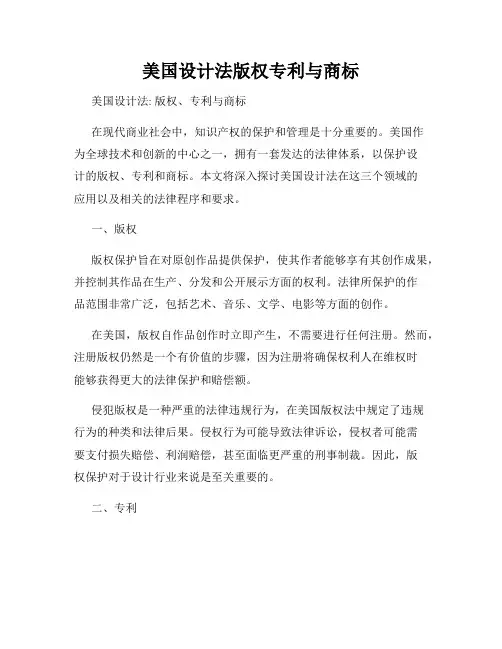
美国设计法版权专利与商标美国设计法: 版权、专利与商标在现代商业社会中,知识产权的保护和管理是十分重要的。
美国作为全球技术和创新的中心之一,拥有一套发达的法律体系,以保护设计的版权、专利和商标。
本文将深入探讨美国设计法在这三个领域的应用以及相关的法律程序和要求。
一、版权版权保护旨在对原创作品提供保护,使其作者能够享有其创作成果,并控制其作品在生产、分发和公开展示方面的权利。
法律所保护的作品范围非常广泛,包括艺术、音乐、文学、电影等方面的创作。
在美国,版权自作品创作时立即产生,不需要进行任何注册。
然而,注册版权仍然是一个有价值的步骤,因为注册将确保权利人在维权时能够获得更大的法律保护和赔偿额。
侵犯版权是一种严重的法律违规行为,在美国版权法中规定了违规行为的种类和法律后果。
侵权行为可能导致法律诉讼,侵权者可能需要支付损失赔偿、利润赔偿,甚至面临更严重的刑事制裁。
因此,版权保护对于设计行业来说是至关重要的。
二、专利专利保护是为了鼓励创新和发明,并保护发明者的技术成果。
专利提供了对发明的专有权,阻止其他人未经许可使用、制造、销售或导入涉及该发明的产品或方法。
在美国,专利主要分为实用新型专利和发明专利两种类型。
实用新型专利适用于新的和有实用性的发明,而发明专利适用于新的、非显而易见和有实用性的发明。
申请专利需要进行书面申请,并满足法定的专利要求,如新颖性、非显而易见性和实用性。
专利保护的期限一般为20年。
在保护期限内,专利持有人有权阻止他人在没有许可的情况下使用或利用他们的专利。
违反专利权可能导致侵权和损害赔偿等法律后果,因此专利的保护也是创新产业中的核心需求。
三、商标商标是指用于识别和区分商品或服务来源的符号、标记或设计。
它可以是文字、图形、图案、颜色、声音等,其主要目的是保护商业标识以及消费者对商品或服务的辨识度。
在美国,商标注册是保护商标权益的重要手段。
通过注册商标,商标持有人可以获得在整个国家范围内的独立和专有使用权,并有权追究未经许可使用其商标的侵权行为。
美国专利法
1787年颁布的《美国联邦宪法》确立了美国的联邦体制,第8条授予国会的立法权之一就是:“为促进科学和实用技艺的进步,对作家和发明家的著作和发明,在一定期限内给予专利权的保障”。
正如当时美国国父之一詹姆斯•麦迪逊在《联邦党人文集》所指出的那样:无法通过各州分别的立法来保护发明,所以在起草《美国宪法》时,将专利法的立法权授予了联邦的国会。
一个趣闻就是,当时的制宪会议在费城召开时,在中午休会期间安排了一场观览活动。
参加制宪会议的代表登上了约翰•惠奇(John Fitch)所发明的45英尺长的蒸汽船,见证了这艘新型蒸汽船在特拉华河上举行的试航。
根据宪法的规定,国会在1790年颁布了美国历史上的首部专利法。
1791年8月26日,约翰•惠奇也因为发明蒸汽船而获得了美国的专利。
1787年颁布的《美国联邦宪法》确立了美国的联邦体制,第8条授予国会的立法权之一就是:“为促进科学和实用技艺的进步,对作家和发明家的著作和发明,在一定期限内给予专利权的保障”。
正如当时美国国父之一詹姆斯•麦迪逊在《联邦党人文集》所指出的那样:无法通过各州分别的立法来保护发明,所以在起草《美国宪法》时,将专利法的立法权授予了联邦的国会。
一个趣闻就是,当时的制宪会议在费城召开时,在中午休会期间安排了一场观览活动。
参加制宪会议的代表登上了约翰•惠奇(John Fitch)所发明的45英尺长的蒸汽船,见证了这艘新型蒸汽船在特拉华河上举行的试航。
根据宪法
的规定,国会在1790年颁布了美国历史上的首部专利法。
1791年8月26日,约翰•惠奇也因为发明蒸汽船而获得了美国的专利。
美国知识产权法制简况1. 知识产权的定义知识产权是指人们对于自己独创的或拥有的智力成果所享有的一种权利。
它包括了专利权、商标权、著作权、商业秘密等。
2. 美国知识产权法的体系美国的知识产权法主要包括专利法、商标法、著作权法和商业秘密法。
2.1 专利法专利法主要保护发明的独特性和创造性。
美国专利法将可被保护的发明分为三类:实用新型、设计以及植物品种。
专利权的保护期限为20年。
2.2 商标法商标法主要保护商标的独特性和品牌价值。
美国商标法要求商标具有区分度和独特性,并对商标的注册和使用进行规范。
2.3 著作权法著作权法主要保护文学、艺术和音乐作品的原创性。
美国著作权法规定了作品的保护期限以及权利人的权益。
2.4 商业秘密法商业秘密法主要保护商业信息的机密性和保密性。
美国商业秘密法规定了商业秘密的定义、保护措施和违法行为等内容。
3. 知识产权法律保护的重要性知识产权法律保护的重要性在于鼓励创新和保护创造者的权益。
知识产权产生的经济价值和社会价值不可忽视,对于创新经济的发展起到了积极的推动作用。
4. 美国知识产权法的挑战和改革美国知识产权法面临着一些挑战,如滥用专利和商标权力、侵权行为的增加等。
为了适应新的技术和商业环境,美国知识产权法也进行了一系列的改革,以保持其有效性和适应性。
5. 美国知识产权保护的国际合作美国积极参与了国际知识产权组织和多边贸易协定等国际合作机制,以加强知识产权在全球范围内的保护和管理。
,美国的知识产权法制完善,包含了专利法、商标法、著作权法和商业秘密法等法律体系。
这些法律保护了创新者和创造者的权益,促进了创新经济的发展。
为了应对挑战和适应新的环境,美国也进行了一系列的改革。
美国也积极参与国际合作,加强知识产权在全球范围内的保护。
美国专利侵权损害赔偿额的有关规定关于专利侵权赔偿额的有关规定,美国通过自己的探索建立比较完善化、系统化规定,对完善我国的专利侵权损害赔偿额的有关规定有积极的借鉴作用,笔者希望通过梳理美国的规定,能为我们提供良好的借鉴。
一、美国美国在计算专利侵权损害赔偿额时采用了权利人所遭受的损失、合理使用费这两种方式。
美国专利法第284、285条规定了在侵权损害赔偿额上不少于侵权者使用发明应支付的合理的专利使用费,包括利息和相关的费用,将使用费作为赔偿额最低标准。
同时对故意侵权行为也规定了惩罚性赔偿的条款,以加强对故意侵权者的惩戒。
美国在大量的司法实践中通过判例确立的具体计算侵权赔偿额的方法。
针对权利人损失的计算,美国法院通过假定在不存在侵权行为时,权利人所应获得利益来证明损失和侵权行为之间的因果关系。
在Panduit Corpv.Stahlin Bros.Fobre Works一案中确立了Panduit测试法,在权利人请求赔偿时必须证明:①专利产品存在实际市场,这是获得赔偿最基本的前提;②市场上没有可接受的非侵权替代品;③权利人满足市场需求的能力;④不存在侵权情况下应获得的市场利润。
这一测试方法在市场上只存在权利人和侵权人这两个相互竞争者的情况时十分有效,但是这种情况在市场竞争中其实是很少的,绝大多数的情况下在同一市场中都存在多个竞争者,因此美国联邦巡回上诉法院于1989年State Indus.,Inc.v.Mor-Flo Indus.,Inc一案中,确立了市场占有比例分析法,权利人应该证明在多个竞争者存在的市场中,其所占的市场份额的比例,仅可以就其所占有的市场比例之内的对应的损失请求损害赔偿。
同时由于越来越多的产品中包含的不仅仅是专利技术,专利技术可能只是产品的组成部分,对于这种情况下损失的计算美国确立了全部市场价值规则和技术分摊规则。
全部市场价值规则是指按照整个产品的利润来计算专利权人的损失,在适用这一原则时需要考虑三个条件(1)专利技术特征必须成为消费者所购买的整个产品的基础;(2)专利权人必须合理地期望将非专利部件连同专利部件一起销售;(3)非专利部件与专利部件在功能性上形成一个单元。
35 U.S.C. 101 Inventions patentable.Whoever invents or discovers any new and useful process, machine, manufacture, or composition of matter, or any new and useful improvement thereof, may obtain a patent therefore, subject to the conditions and requirements of this title.35 U.S.C. 102 Conditions for patentability; novelty and loss of right to patent.A person shall be entitled to a patent unless -(a) the invention was known or used by others in this country, or patented or described in a printed publication in this or a foreign country, before the invention thereof by the applicant for patent, or(b) the invention was patented or described in a printed publication in this or a foreign country or in public use or on sale in this country, more than one year prior to the date of the application for patent in the United States, or(c) he has abandoned the invention, or(d) the invention was first patented or caused to be patented, or was the subject of an inventor's certificate, by the applicant or his legal representatives or assigns in a foreign country prior to the date of the application for patent in this country on an application for patent or inventor's certificate filed more than twelve months before the filing of the application in the United States, or(e) the invention was described in - (1) an application for patent, published under section 122(b), by another filed in the United States before the invention by the applicant for patent or (2) a patent granted on an application for patent by another filed in the United States before the invention by the applicant for patent, except that an international application filed under the treaty defined in section 351(a) shall have the effects for the purposes of this subsection of an application filed in the United States only if the international application designated the United States and was published under Article 21(2) of such treaty in the English language; or(f) he did not himself invent the subject matter sought to be patented, or(g)(1) during the course of an interference conducted under section 135 or section 291, another inventor involved therein establishes, to the extent permitted in section 104, that before such person's invention thereof the invention was made by such other inventor and not abandoned, suppressed, or concealed, or (2) before such person's invention thereof, the invention was made in this country by another inventor who had not abandoned, suppressed, orconcealed it. In determining priority of invention under this subsection, there shall be considered not only the respective dates of conception and reduction to practice of the invention, but also the reasonable diligence of one who was first to conceive and last to reduce to practice, from a time prior to conception by the other.35 U.S.C. 103 Conditions for patentability; non-obvious subject matter.(a) A patent may not be obtained though the invention is not identically disclosed or described as set forth in section 102 of this title, if the differences between the subject matter sought to be patented and the prior art are such that the subject matter as a whole would have been obvious at the time the invention was made to a person having ordinary skill in the art to which said subject matter pertains. Patentability shall not be negatived by the manner in which the invention was made.(b)(1) Notwithstanding subsection (a), and upon timely election by the applicant for patent to proceed under this subsection, a biotechnological process using or resulting in a composition of matter that is novel under section 102 and non-obvious under subsection (a) of this section shall be considered non-obvious if-(A) claims to the process and the composition of matter are contained in either the same application for patent or in separate applications having the same effective filing date; and(B) the composition of matter, and the process at the time it was invented, were owned by the same person or subject to an obligation of assignment to the same person.(2) A patent issued on a process under paragraph (1)-(A) shall also contain the claims to the composition of matter used in or made by that process, or(B) shall, if such composition of matter is claimed in another patent, be set to expire on the same date as such other patent, notwithstanding section 154.(3) For purposes of paragraph (1), the term "biotechnological process" means-(A) a process of genetically altering or otherwise inducing a single- or multi-celled organism to-(i) express an exogenous nucleotide sequence,(ii) inhibit, eliminate, augment, or alter expression of an endogenous nucleotide sequence, or(iii) express a specific physiological characteristic not naturally associated with said organism;(B) cell fusion procedures yielding a cell line that expresses a specific protein, such as a monoclonal antibody; and(C) a method of using a product produced by a process defined by subparagraph (A) or (B), or a combination of subparagraphs (A) and (B).(c)(1) Subject matter developed by another person, which qualifies as prior art only under one or more of subsections (e), (f), and (g) of section 102 of this title, shall not preclude patentability under this section where the subject matter and the claimed invention were, at the time the claimed invention was made, owned by the same person or subject to an obligation of assignment to the same person. (2) For purposes of this subsection, subject matter developed by another person and a claimed invention shall be deemed to have been owned by the same person or subject to an obligation of assignment to the same person if -(A) the claimed invention was made by or on behalf of parties to a joint research agreement that was in effect on or before the date the claimed invention was made;(B) the claimed invention was made as a result of activities undertaken within the scope of the joint research agreement; and(C) the application for patent for the claimed invention discloses or is amended to disclose the names of the parties to the joint research agreement.(3) For purposes of paragraph (2), the term "joint research agreement" means a written contract, grant, or cooperative agreement entered into by two or more persons or entities for the performance of experimental, developmental, or research work in the field of the claimed invention.35 U.S.C. 112 Specification.The specification shall contain a written description of the invention, and of the manner and process of making and using it, in such full, clear, concise, and exact terms as to enable any person skilled in the art to which it pertains, or with which it is most nearly connected, to make and use the same, and shall set forth the best mode contemplated by the inventor of carrying out his invention.The specification shall conclude with one or more claims particularly pointing out and distinctly claiming the subject matter which the applicant regards as his invention.A claim may be written in independent or, if the nature of the case admits, in dependent or multiple dependent form.Subject to the following paragraph, a claim in dependent form shall contain a reference to a claim previously set forth and then specify a further limitation of the subject matter claimed. A claim in dependent form shall be construed to incorporate by reference all the limitations of the claim to which it refers.A claim in multiple dependent form shall contain a reference, in the alternative only, to more than one claim previously set forth and then specify a further limitation of the subject matter claimed. A multiple dependent claim shall not serve as a basis for any other multiple dependent claim. A multiple dependent claim shall be construed to incorporate by reference all the limitations of the particular claim in relation to which it is being considered.An element in a claim for a combination may be expressed as a means or step for performing a specified function without the recital of structure, material, or acts in support thereof, and such claim shall be construed to cover the corresponding structure, material, or acts described in the specification and equivalents thereof.。